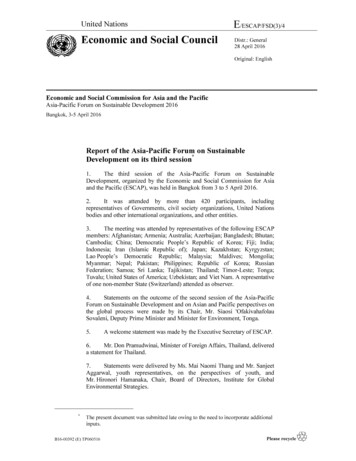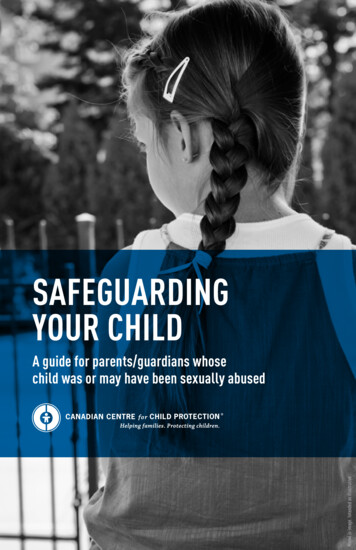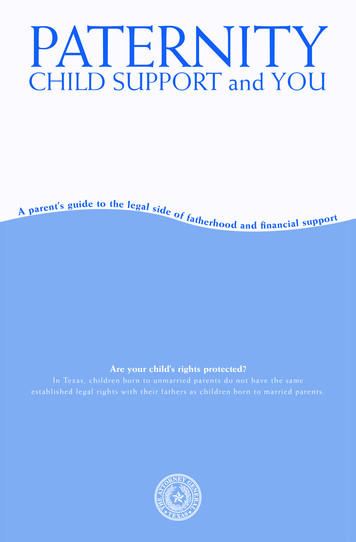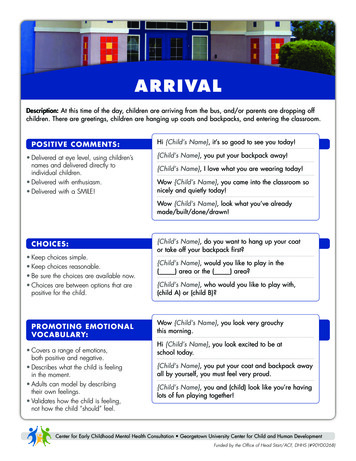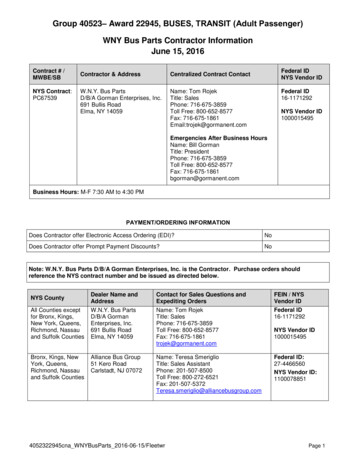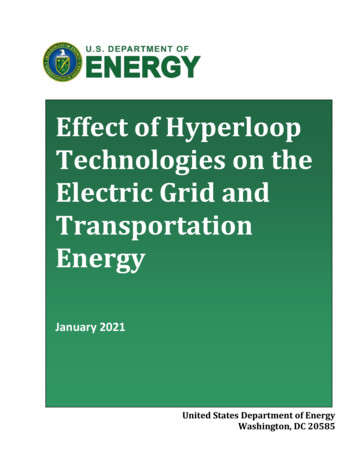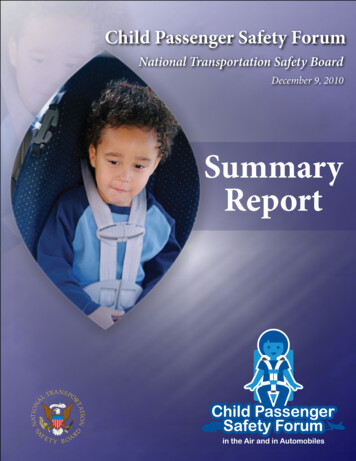
Transcription
Child Passenger Safety ForumNational Transportation Safety BoardDecember 9, 2010ESummaryReportPLUR I BU SUNU M
Safety for our smallest travelers should not beconsidered optional or a luxury.—Deborah A.P. Hersman,ChairmanCO NTENTSINTRODUCTION1AVIATION PANEL, PART I1Federal Aviation Administration and Flight Attendant Union PerspectivesMr. DeWeese’s Comments1Ms. Claussen’s Comments 3Ms. Friend’s Comments 3General Discussion 41AVIATION PANEL, PART II4HIGHWAY SAFETY PANEL5Perspectives from Industry 4Mr. Meenan’s Comments 4Ms. Vasconcelos’s Comments 5Ms. Gooding’s Comments 5Mr. Sinclair’s Comments 5Dr. Arbogast’s Comments 6Dr. McCartt’s Comments 7Dr. Rouhana’s Comments 8General Discussion 9MOVING FORWARD: SOLUTIONS THAT WORK10EXCERPT OF CLOSING REMARKS FROMCHAIRMAN DEBORAH HERSMAN16LINKS TO KEY NTSB STATEMENTS FORCHILD OCCUPANT SAFETY IN AUTOMOBILES AND IN AIRCRAFT16Dr. Baldwin’s Comments 10Dr. Durbin’s Comments 12Mr. Decina’s Comments 13Ms. Walker’s Comments 14Mr. Campbell’s Comments 14General Discussion 15i
Child Passenger Safety ForumSummary ReportINTRODUCTIONOn December 9, 2010, the National Transportation Safety Board (NTSB) held a day-long forumdevoted to child passenger safety. The primary purpose of the forum was to improve child safetyin airplanes and in automobiles through education and advocacy aimed toward the caregivers ofchildren and the transportation industry. Another purpose was to identify effective strategies toincrease child seat and seat belt use rates. This report summarizes key points made by each speakerand discussions with the panel members following their presentations. The views expressed do notnecessarily represent the official positions of the NTSB. Links to key NTSB statements concerningchild occupant safety in aircraft and in automobiles are listed at the end of this summary.AVIATION PANEL, PART IFederal Aviation Administration and Flight Attendant Union PerspectivesMr. Rick DeWeese, Civil Aerospace Medical Institute, Federal Aviation Administration (FAA)Ms. Nancy Claussen, Federal Aviation Administration (FAA)Ms. Patricia Friend, Association of Flight AttendantsMr. DeWeese’s Comments Lap-held children: Not safe. Children younger than age 2 are not safe during turbulence orin a crash while being held in laps on airplanes. Use government-approved child seats on airplanes (look for Red Letters on label): This isthe best way to ensure a child’s safety during turbulence or an emergency. Most automotivechild seats (rear- or forward-facing) sold in stores are also approved for use in aircraft. DeWeese about crashes: “if the child is trapped between the seat in front and theadult, it [the child] could be crushed.”Persons holding a child “cannot react fast enough to counter an unanticipated andsuddenly applied load as occurs during turbulence. They also just don’t have enoughstrength to hold onto a child during extreme loading conditions that can occur duringa crash landing.”The FAA strongly recommends, but does not mandate, this practice.Babies: Infants should be in rear-facing child seats while flying. Rear-facing child seats have a protective shell that distributes crash forces evenly andprevents the child from hitting surrounding objects.Toddlers: Children who are too large for rear-facing seats should fly in forward-facing childseats with internal harnesses. Small children using only a lap belt can receive spinal cord injuries or hit their headsagainst seat frames. Using a forward-facing child seat reduces the risk of head injuriesby reducing forward excursion.National Transportation Safety Board 1
Child Passenger Safety Forum Summary ReportWhen are children ready to use lap belts? There is no precise age at which it is safe for children to graduate from child seats tolap belts. The height and weight of the child determines this. Parents should look atthe size limits marked on their child restraints to see if they are appropriate to use.FAA research has focused on child seats with internal harnesses for children weighing40 pounds or less.Information from the FAA’s WebsiteAlways follow the manufacturer’s instructions when using a CRS [child restraint system].FAA recommends that a child weighing: Less than 20 pounds use a rear-facing CRSFrom 20 to 40 pounds use a forward-facing CRSMore than 40 pounds use an airplane seat beltA child may also use an alternative, such as a harness-type restraint, if it isapproved by FAA. FAA has approved one restraint appropriate for childrenweighing between 22 and 44 pounds.”Source: http://www.faa.gov/passengers/fly children/crs . Belly belts and baby slings: Belly belts and similar devices (baby slings, vests, etc.) thatfasten children to adults are prohibited by the FAA during takeoff, landing, and surfacemovement. They can help restrain a child during turbulence but do not provide protectionduring crash landings. Lab tests show that, during crash landings, children in belly belts may be crushedbetween adults and seat backs or may be ejected from laps. They are not protectedand may be injured or killed.Using child seats on airplanes: Child seats are attached to the airplane seat with the airplaneseat’s lap belt. Airplane seats do not have the LATCH1 system, which is common in mostmotor vehicles. FAA has a video on its website showing parents how to fasten forward-facing childseats in airplanes: http://www.faa.gov/tv/?mediaId 228 Website on flying with children: http://www.faa.gov/passengers/fly children/ If child seat is less than 16 inches wide, it should fit into all airline seats, includingcommuter airlines.Children may need to be moved to an airplane seat with more room between rows toaccommodate seats, especially the larger rear-facing ones.Rows behind walls, referred to as bulkhead seats, often have enough space toaccommodate rear-facing child seats.1. LATCH stands for Lower Anchors and Tethers for Children.National Transportation Safety Board 2
Child Passenger Safety ForumSummary Report Ms. Claussen’s Comments Why the FAA does not require that children younger than 2 be restrained: The FAA has notmandated proper restraint for children younger than age 2 because they worry that some familiesmay choose to drive instead of fly if required to purchase an additional seat. Because commercialaviation is safer than motor vehicle travel, this could result in more child deaths on the road. Enforcement: The FAA has taken few enforcement actions against airlines relating towhether they allowed children older than age 2 to be held in laps. Statistics on how many children younger than 2 fly in commercial aviation: The FAAestimates that one percent of all passengers are children younger than age 2 but does nothave exact numbers. Statistics on how many children younger than 2 fly restrained: FAA does not have thisinformation.Ms. Friend’s Comments Association of Flight Attendants: Wants a mandate to prohibit children from being held onlaps. Said that parents do not keep a tight grip on children during the entire flight.Unexpected (clear air) turbulence can occur while the seat belt sign is not lit andparents will be unable to react quickly enough.Quote from flight attendant: “I have to tell passengers that they cannot hold theirlaptop computer on their lap; however, a wiggly 20-pound human is allowed.”Children are used to riding in child seats in automobiles, so they may be resistant tobeing held on laps and may be more comfortable in their own child seats.Flight attendants sometimes see children who appear to be older than age 2 (andwithout their own seat) held on laps during takeoff/landing; some attendants do not feelcomfortable questioning parents about whether their children are younger than age 2.National Transportation Safety Board 3
Child Passenger Safety Forum Summary ReportDisagrees with the FAA’s concern that requiring all passengers to have their ownseats will result in diversion to highway travel. Thinks that FAA’s analysis did not takeimportant factors into account.Unless there is a mandate, parents will incorrectly perceive that it is safe to holdchildren on laps.Friend stressed the need for more training for flight attendants regarding childrestraints. Ms. Friend pointed out that some airline websites make it difficult to buy tickets forchildren younger than 2: Some airline websites assume parents will not want to buy ticketsfor children younger than age 2. To buy a ticket, parents may have to claim that theirchildren are age 2 or older.General Discussion There was discussion about whether the booster seat prohibition was appropriate forgeneral aviation airplanes with shoulder belts. There was discussion about education for owners and pilots of general aviation aircraftconcerning child passenger safety. The FAA has made some efforts to disseminateinformation to them.AVIATION PANEL, PART IIPerspectives from IndustryMr. John Meenan, Air Transport AssociationMs. Kathleen Vasconcelos, Aircraft Owners and Pilots Association Air Safety Foundation (AOPA)Ms. Mary Gooding, Virgin Atlantic AirlinesMr. Meenan’s Comments Recommends that parents have a discussion with the airline when booking seats about thebest places to put a child restraint. Statistics on number of children flying: The Transportation Security Administration hasa Secure Flight advance passenger review system in which every passenger is required tobe identified, including their birth date. It may be possible to get a more exact count ofchildren from this database. Flight manifest data are supposed to record all passengers but are not kept on along-term basis. Nobody is using flight manifest data to track how many children,including lap-held children, are flying.National Transportation Safety Board 4
Child Passenger Safety ForumSummary ReportMs. Vasconcelos’s Comments AOPA has educational materials for private pilots about child safety and answers questionsfrom both members and non-members. Accidents: There have been general aviation accidents where children appear to havesurvived because they were using a child seat. There have also been accidents wherechildren have died because they were not restrained. NTSB Aviation Accident/Incident Database: Does not consistently identify ages ofpassengers and their restraint status. These are not standard data fields.General aviation data: Rear seat is safer for children than front seat, just as inautomobiles.Children are a distraction in the front seat and also can impede the full range ofmotion for the control yoke. Having them close to cockpit controls is a problem.General aviation challenge: Some 4-point harnesses do not accommodate child seats;Vasconcelos thinks there is a need to look at this problem.Ms. Gooding’s Comments Virgin Atlantic Airlines has unique efforts to promote child passenger safety. Since 1992, they have provided aviation-certified child seats to parents who buy seatsfor their children so that parents do not have to carry automotive child seats throughairports.Provides child seats that can be used rear-facing or forward-facing and carry a few onevery airplane.Does deep cleaning of child seats every eight weeks and more often as needed.Offers discounted fares to infants.Crew installs aviation child seats; parents do not install the devices. Encouragespeople traveling with young children to purchase seats for them. Reservation agentsmention this possibility to people who want to travel with infants.Collects data on how many children travel and whether they are using a child restraintprovided by Virgin Atlantic.HIGHWAY SAFETY PANELMr. Alexander Sinclair, National Highway Traffic Safety Administration (NHTSA)Dr. Kristy Arbogast, Children’s Hospital of Philadelphia (CHOP)Dr. Anne T. McCartt, Insurance Institute for Highway Safety (IIHS)Dr. Stephen Rouhana, Ford Motor CompanyMr. Sinclair’s Comments National Transportation Safety Board 5
Child Passenger Safety ForumSummary Report In 2009, there were 322 passenger vehicle occupant fatalities among children ages 4 andyounger and over 30% of these children were totally unrestrained. On average, 490 children a day (ages 14 or younger) were injured in highway crashes in2009. Car seats saved an estimated 309 lives in 2009; they could have saved 63 more lives if 100%of children used them. Younger children (i.e., infants and toddlers) are the most likely to be in the correct restrainttype, and as children age, the rates of appropriate restraint use decline. For children younger than age 4, 98–99% of them are in an appropriate restraint.Booster seat use for children ages 4–7 is much lower. It is 41% and has been about thatlevel for years.There are also lower usage rates in general for low-income families, Hispanics, andAfrican Americans.The percentage of children seated in back, the safest place for them, has risen;although, not every state requires children to be seated in the back. As of 2010, 47 states and the District of Columbia now require booster seat use. State lawsvary quite a bit in terms of age requirements for booster seat use. NHTSA recommended practices: Children should be seated in the back.Keep infants in rear-facing seats up to the maximum weight requirement for the seat(minimum of age 12 months and 20 pounds).Next step is graduating to forward-facing child seats, which they should stay in untilthey reach the upper height or weight limits of the rear-facing seat.Next step is graduating to booster seats, which they should use until vehicle seat beltsfit them properly.Older children should wear lap/shoulder belts and stay in the back seat. Every trip is a potentially dangerous trip, including short trips. Parents need to hear thismessage. NHTSA incentives for states to strengthen seat belt laws and booster seat laws have beeneffective.Dr. Arbogast’s Comments With assistance from State Farm Insurance, CHOP collected and analyzed child-specificcrash data from 1998–2007, and those data informed much of what we know about childsafety in autos today.National Transportation Safety Board 6
Child Passenger Safety Forum Such data are useful because they can guide the use of limited resources. The followingfindings have guided state laws for booster seats and policy recommendations: Children in rear-facing seats: 44% lower risk of moderate/severe injury than amongchildren in forward-facing seats.Children in forward-facing seats: 28% lower risk of moderate/severe injury thanamong children in seat belts.Children in booster seats: 45% lower risk of moderate/severe injury than children inseat belts.CHOP will have a partnership with NHTSA to explore how they can use the NationalAutomotive Sampling System (NASS) infrastructure to create a national resource for childcrash data. It will be called the National Child Occupant Special Study (NCOSS). Pilotstudies are being funded by industry and IIHS. Summary ReportSuch studies may be able to evaluate recent technologies such as higher weight limitsfor child restraint systems (CRS), vehicle side impact structure improvements, andbooster seat use.Child occupant protection is more than child restraints, especially for older children. “Why should those 8- to 12-year-olds and 13- to 15-year-olds have a higher risk ofinjury than their younger siblings?” Arbogast said there is a need to keep conducting public health surveillance on childreninvolved in crashes to understand emerging trends and problems. Arbogast said that the rear seat environment should be optimized for all occupants,including children. The Kohl’s Safety Center at CHOP has been a good resource for the people of southeasternPennsylvania. People can purchase child seats and learn how to use them as well as othersafety devices.Dr. McCartt’s Comments Too many children are still not restrained at all. Many children are not riding in restraints that are best for their age. For example, too many4- to 8-year-old children are riding with seat belts alone when they should be using boosterseats. State laws vary in terms of ages for booster seats, and there is room for improvement inthese laws.National Transportation Safety Board 7
Child Passenger Safety ForumSummary Report IIHS worked with the University of Michigan Transportation Research Institute (UMTRI)to develop a system for evaluating booster seats in terms of lap/shoulder belt fit using adummy representing a 6-year-old child. They use the system to rate boosters and publishthe results for parents/consumers. Dr. McCartt believes it has led to better designs bybooster seat manufacturers. Using a top tether is a simple way to keep children in forward-facing seats safer, but tetheruse is low. A NHTSA study found that tethers were being used in only about half of seatswith tethers and anchors. When tethers were used, they were often too loose. A recent IIHSstudy found that for 2001 model year or newer cars, the tether was used 47% of the timeand was adjusted tautly 43% of the time. The IIHS observed lower use rates for tethers in pickup trucks than cars. Many parents are not getting the message about the importance of using tethers and donot necessarily understand that they should use the tether even when using the seat belt toattach the child seat to the vehicle. IIHS is currently working with UMTRI to evaluate the usability of LATCH systems. Belt use rates decrease among older children and pre-teens; McCartt says there is a need towork on this problem. McCartt thinks NHTSA regulations for boosters should include criteria for goodness-of-fit. McCartt suggested that aggressive belt-reminder systems may be a promising technologyfor increasing seat belt use among older children who have graduated from booster seats.Dr. Rouhana’s Comments For many years, Ford has been looking for ways to improve occupant protection in the rearseats of motor vehicles.Ford has worked for a decade to develop inflatable belt systems for rear seats, and they arejust beginning to offer them as an option on new Ford Explorers in March 2011.Inflatable belts are designed to be used with, not to replace, existing child restraint systems.They are designed to reduce occupant head excursion, help limit occupant neck loads(reduce neck injury), and distribute belt loads over more of the chest (reduce chest injury).Inflatable belts are expected to benefit all occupants, especially children, smaller occupants,and elderly people.National Transportation Safety Board 8
Child Passenger Safety ForumSummary Report Many 8-year-old children are too small for seat belts, although state laws typically do notmandate booster seats for children who are age 8 or older. Many children do not properly fitinto seat belts until they are much older than age 8.General Discussion Laws that are enforced are very effective at changing behavior and getting the message outto parents. The NTSB has investigated catastrophic accidents in which children in child seats survivedbut adults were fatally injured as well as accidents where children were fatally injuredbecause they were not in child seats or seat belts. No current government rating systems expressly focus on vehicle rear seat safety or childseat compatibility with automobiles (NHTSA evaluates ease of use but not safety orcompatibility). Manufacturers may lack incentives to improve rear seats in the absence of rating systemsor consumer information programs. One difficulty in implementing such a program isthe fact that there are so many auto/child restraint system variations to consider. Currently, there is no known relationship between booster seat fit and safety in a crash. TheNHTSA/CHOP effort could shed some light on this. Police-reported data on types of childrestraints used are not reliable. One challenge is that child restraint laws are typically based on children’s ages, whereasthe best practices for child restraint use ideally should be based on the fit of the restraints.However, it is difficult to write regulations based on fit. Regulations based on height/weightwould be difficult to enforce. The presenters thought that it would be desirable to have an integrated vehicle restraintsolution for older children instead of boosters, which were referred to as a “band-aidapproach.” Such systems were once available, but were not commercially successful. There are still improvements that could be made in standardizing and making it easier toinstall child safety seats (e.g., LATCH standardization). Tether anchors are not standardized and are in a variety of different locations on the vehicle.They sometimes are hard to use, which may reduce use rates. There is a movement to improve safety communication to groups with lower child seatuse rates including low-income Hispanic and African American populations. For example,research has suggested that using word of mouth, faith-based organizations, and shortfotonovelas might be a good means of communicating with Hispanic populations.National Transportation Safety Board 9
Child Passenger Safety ForumSummary Report Economic issues may influence the choices of some parents. That is, they may not be ableto afford child safety seats, especially a succession of child seats for different ages. Medicaiddoes not fund child safety seats unless the child has a defined medical need. Some programsfor distributing child safety seats to low income families have been successful. One panelist suggested that a more portable child safety seat would be helpful for familiesthat rely on public transport or transport from friends. It’s hard for families who do not owna car to carry a 30–40 pound seat and one or more children. U.S. Department of Transportation Secretary Ray LaHood has publicly announced hisintention for NHTSA to develop and implement a correct fit program that would assesshow a particular child seat fits into a certain vehicle because that is the “number onedilemma for parents.” Another area for future research is the long-term outcomes of children involved in crashesas opposed to only focusing on fatalities and acute injuries. The large proportion of children who are being restrained properly now is a success story,but there are still areas that need improvement.MOVING FORWARD: SOLUTIONS THAT WORKDr. Grant Baldwin, Centers for Disease Control and PreventionDr. Dennis Durbin, American Academy of PediatricsMr. Lawrence Decina, TransAnalyticsMs. Lorrie Walker, Safe Kids WorldwideMr. David Campbell, Juvenile Products Manufacturers AssociationDr. Baldwin’s Comments Public health model: valuable framework for problem-solving. Involves multiple stages:1. Surveillance,2. Risk and protective factor identification,3. Development of programs and policies, and4. Evaluation and implementation of evidence-based interventions on larger scale. Need to consider social ecology: address factors that encourage or discourage child seat use(e.g., costs, parental knowledge, social norms, burden of carrying car seats through airport,etc.). Need to broaden view of points of intervention and learn lessons from previousbehavior change initiatives.National Transportation Safety Board 10
Child Passenger Safety ForumSummary Report Important to apply behavioral and social science theory to public health problems. HealthBelief Model points to perceived threat, perceived susceptibility, perceived benefits, andperceived barriers. There also are other useful theories (Theory of Planned Behavior, SocialCognitive Theory). Multiple factors influencing behavior means there are multiple opportunities tointervene. Dr. Baldwin’s list of ten approaches to changing behavior: Evaluation of program outcomes is essential. Centers for Disease Control and Preventionmandates that evaluation be included in any funded programs. Evaluating process, such as web hits, as described by FAA, is useful, but it is notsufficient. Other high-risk groups for vehicle occupant deaths and injuries: Native Americans andAlaskan Natives. Unfortunate that children in states with less stringent laws are exposed to higher risks thanchildren in states with stronger child restraint laws. Mass media campaigns may not be an effective method to reach the people who are not yetusing child seats and seat belts. Improved laws and enhanced enforcement may be moreeffective. Currently, parents have to opt in to buy an airplane seat for their children younger thanage 2. Baldwin said that use rates might increase if the default option is buying a seat forchildren unless parents choose to opt out.National Transportation Safety Board 11
Child Passenger Safety ForumSummary ReportDr. Durbin’s Comments Best practices as recommended by the American Academy of Pediatrics: Children should ride in rear-facing child seats until they reach the maximum height/weight limits for their particular child seat. Riding in rear-facing child seats until oneyear of age and 20 pounds is a minimum standard; extending that period of time isdesirable. Many rear-facing child seats can now accommodate children up to 35 pounds(larger than most 24-month-olds). Caregivers should keep toddlers in forward-facing child seats until they reach heightand weight limits for that seat before graduating them to booster seats. Many forward-facing child seats can now accommodate children up to 50pounds (larger than most 5-year-olds). Use belt-positioning booster seats until vehicle seat belts fit child properly.All children younger than 13 should be seated in rear seats.All older passengers should use both lap and shoulder belts. The American Academy of Pediatrics has an online car seat guide to help caregiversselect seats; it’s updated annually and highlights the wide variety of available products( http://www.aap.org/healthtopics/carseatsafety.cfm ). Pediatricians need to convince parents to be firm with children and not make use of boosterseats negotiable. CHOP did a parent survey and was stunned to find out that most parents let childrenstart making decisions about how to sit in cars at age 4. The American Academy of Pediatrics recommends that all young children flying, includingthose younger than age 2, be restrained in an appropriate child safety seat during takeoff,landing and turbulence. Substantial efforts are being made to disseminate information to pediatricians so thattheir advice to parents is up to date. These efforts include publications, conferences, onlinematerials, and continuing medical education. Pediatricians are asked to counsel parents/caregivers about automotive safety at every health checkup. There is variation among pediatric practices in the extent to which they follow thisrecommendation. To promote child health and development, the American Academy of Pediatrics launched http://www.healthychildren.org , a website for parents and the general public. Childpassenger safety is the most visited part of the website.National Transportation Safety Board 12
Child Passenger Safety ForumSummary Report Durbin: The United States needs to have effective surveillance systems for identifyingproblems, developing and disseminating programs, and evaluating interventions. Adequatequality and quantity of data to monitor child motor vehicle safety is necessary. A mass media campaign with a simple message is often ineffective because it does not targetthe right people in the right circumstances to get them to do the right thing. Lessons learned from automotive safety that can be applied to airplane safety: need to havebetter data on child safety in aircraft. It is easier to make good decisions when good data areavailable; should know how many children are flying. If smart people are drawing oppositeconclusions from the same data, that points to a problem with the data. Example: NHTSAand automobile manufacturers were able to respond quickly to the airbag-induced deathsbecause they had good data. Durbin suggests that Medicaid could cover child seats as durable medical equipment forfamilies with very low incomes. There is evidence that if you make the seat available, peoplewill use it.Mr. Decina’s Comments Misuse of child seats still is common, about 72%. Some population groups are less likely to use child restraints. Usage rates are influencedby income, race, ethnicity, driver age and sex, child age, whether driver uses seat belts,perception of risk, awareness of best practices, type of vehicle (pickup occupants have loweruse rates). Stronger laws and stronger enforcement increase use rates. Enforcement is key component. Seat giveaways work. Faith-based organizations’ efforts to disseminate information about child safety seats appearto increase child seat use rates. Decina: One means to address nonuse of child restraints in automobiles is to designatechild restraint enforcement teams. These police officers do not need to go through the fourday child passenger safety technician course, but they do need supplemental training andallotted time to devote to enforcing child restraint laws. Pre-schools and elementary schools are good resources for reaching caregivers of boosterseataged children. NHTSA’s funding of state programs has been successful in improving motor vehicleoccupant safety.National Transportation Safety Board 13
Child Passenger Safety ForumSummary ReportMs. Walker’s Comments Advocates that parents use car seats to and from airport so they get used at destination. Pointed out many benefits for parents when children use child seats on airplanes: childrenare more comfortable, do not stand up in seats, do not pull people’s hair, less chances formisbehavior. Technicians observe many errors at fitting stations; parents pick seats that do not fit theirautomobile. Childbirth education classes and hospitals are both good places for parent education. Child seat fitting stations have changed their focus from installing child seats for caregiversto teaching caregivers how to install child seats correctly. Caregivers will need these s
Federal Aviation Administration and Flight Attendant Union Perspectives. Mr. Rick DeWeese, Civil Aerospace Medical Institute, Federal Aviation Administration (FAA) Ms. Nancy Claussen, Federal Aviation Administration (FAA) Ms. Patricia Friend, Association of Flight Attendants. Mr. De. W. eese's Comments Lap-held children: Not safe.
![Chap3 Airline Economics[2] - George Mason University](/img/36/chap3-airline-economics-5b2-5d.jpg)
